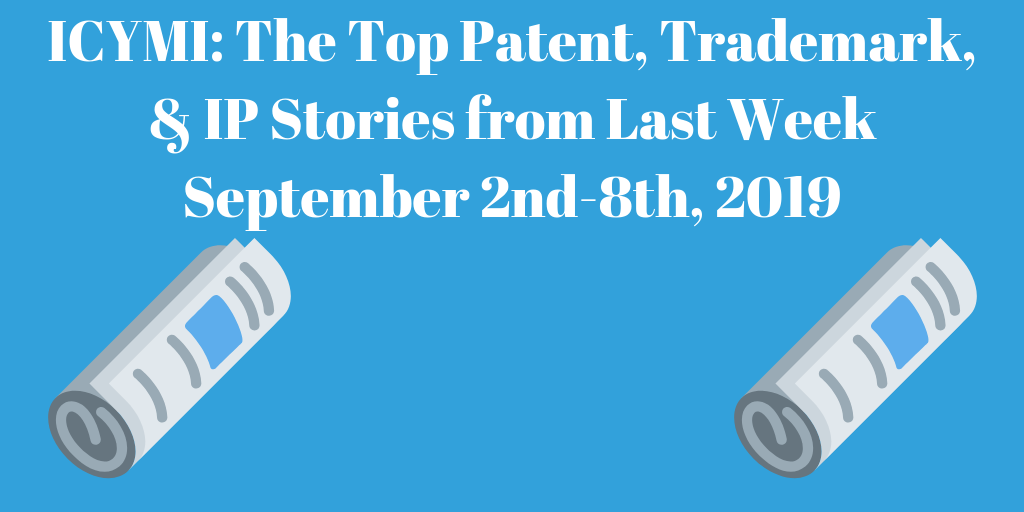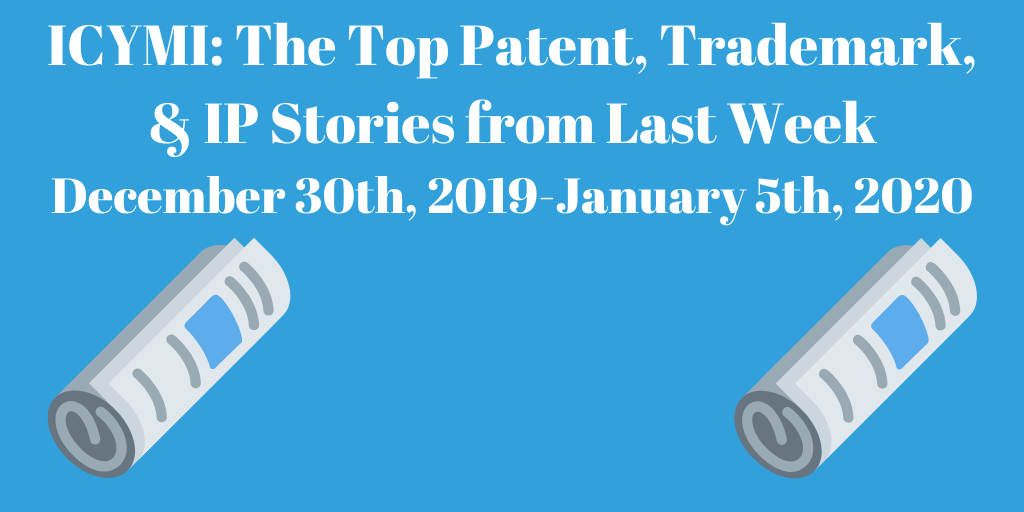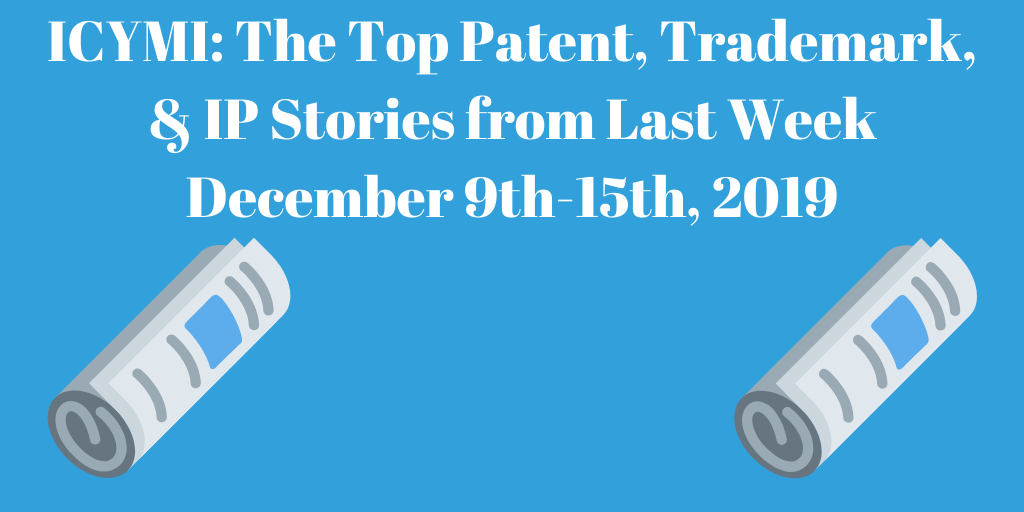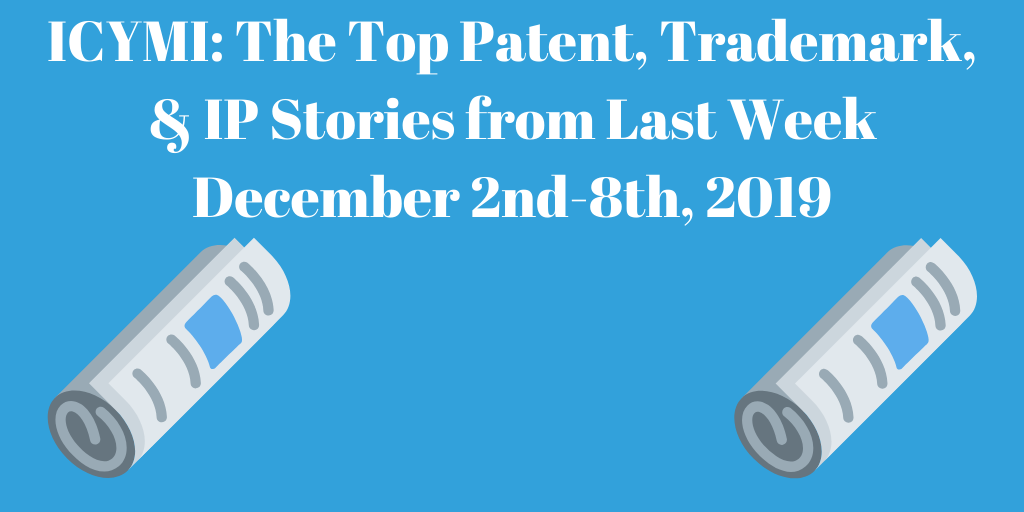Top Patent, Trademark, and IP Stories from Last Week (9/2-9/8/19)
Every week, we will be highlighting the top patent, copyright, trademark, intellectual property, etc. stories of the previous week in our “In Case You Missed It” segment. The list itself is in no particular order and includes a wide range of stories from the patent world that are informative, noteworthy, or just plain bizarre. The stories included encompass everything from Supreme Court cases to insights into growing industries. Please feel free to comment your thoughts on the stories or share an important one we missed!
“Apple Patents Watch Band That Could ID You From Your Wrist Skin”
Last week, Apple was granted three patents for its popular smartwatch, Apple Watch. The first patent, dubbed “Dynamic Fit Adjustment for Wearable Electronic Devices,” outlines a watch band that is able to tighten itself in response to becoming loose. Whether it be through physical activity or normal wear, loosening of the band would send a signal to a tensioner to tighten it to a user preference. This would prevent the user from having to waste time messing around with tightening the band manually every time it comes loose during a run or other strenuous activity. The tightening mechanism could also be used as a notification system of sorts. For example, when the user receives an email or text, the band could discreetly tighten to alert the wearer.
The second smartwatch patent granted is for a “wrist biometric sensor” that is able to build a map of the wearer’s wrist using infrared thermal technology, primarily comprised of skin texture and follicle locations. Much like a fingerprint, the map of a wearer’s wrist would be uniquely identifying and used for authentication applications. This would enable a user to bypass the need for a password or PIN when attempting to access their watch interface.

The third and final patent is for light-up indicators built into the watch band. These would illuminate in response to signals from different apps on the watch or monitor activity. For example, a portion on the band could act as a progress bar for tracking the progress of a run, light up when receiving a text, or flash when a calendar event is in an hour. The possibilities are truly endless and Apple appears to me putting a lot of effort into customizing their watches. To read more about this story, click here (via TechCrunch, September 3rd, 2019).
“Google Files Patent for Using A.I. To Track a Baby’s Body and Eye Movements”
A new patent from Google outlines a baby monitor aka “cloud-based baby monitoring system” that will go far beyond conventional monitor capabilities that rely on human consciousness. Using artificial intelligence, the monitor will learn the behavior of the baby it is observing as well as its normal movements and noises to serve as a reference in its surveillance beyond audible cues. “While a baby’s cry may alert his parents to the baby being in distress, sometimes a baby will not audibly indicate his distress,” the patent states. Essentially, anything outside normal behavior would send an alert to the parents.
One example of this is that the monitor will be able to determine whether the baby is in a non-auditory discomfort state. This determination will be based on a value computed from “various amounts of motion, various baby eye states, and various baby positions.” If the AI determines the baby is in a severe or unusual state, the monitor will alert its parents.

Another interesting feature is the monitor’s ability to determine whether the baby is about to wake up. This will be determined using previous knowledge of the baby’s sleep behavior as well as monitoring for when the baby starts to move, whether its eyes are shut, and the noises it makes. To read more about this story, click here (via CNBC, September 6th, 2019).
“Recent Disney Patent Application Indicates New ‘Smellitzer’ Scent Technology Being Developed for Use at Disney Parks”
A new Disney patent outlines a series of exhaust systems for rides and exhibits that will pump out different scents in order to enhance the guest immersion experience. Fed by scent blending systems, the exhaust systems will pump out a blend of scents at a predetermined time corresponding to events in a scripted entertainment event or ride. Scents will lessen in intensity as a new scent is released, ensuring a balance of scents and the smooth continuation of the story.

The pumps will go beyond simply pumping them in your face however. They will “create a representation of a physical space and physical objects that are represented in the entertainment experience.” This will only enhance the immersion experience for guests on a ride where they are surrounded by its environment or are being moved from one location to another. Disney is pretty active in their R&D activity and their patents tend to be as imaginative as their movies. To read more about this story, click here (via WDWNT.com, September 7th, 2019).
“Tesla Is Developing New Futuristic-Looking Electromagnetic Wipers”
A new Tesla patent lays out a redesign of traditional wiper blades, relying on electromagnetic technology to more efficiently remove rain and snow. Because traditional wiper blades tend to miss large portions of a windshield, Tesla’s new design will use guide rails and electromagnetic moving blocks to move the wiper horizontally across the whole windshield. In order to reduce the friction seen in conventional wipers, the electromagnetic ones will use “current carrying electromagnetic coil in the electromagnetic moving block to generate a magnetic induction-based electrodynamic force to steer the wiper arm.” This will ensure a smooth transition across the windshield without scraping it. To read more about this story, click here (via Electrek, September 6th, 2019).




